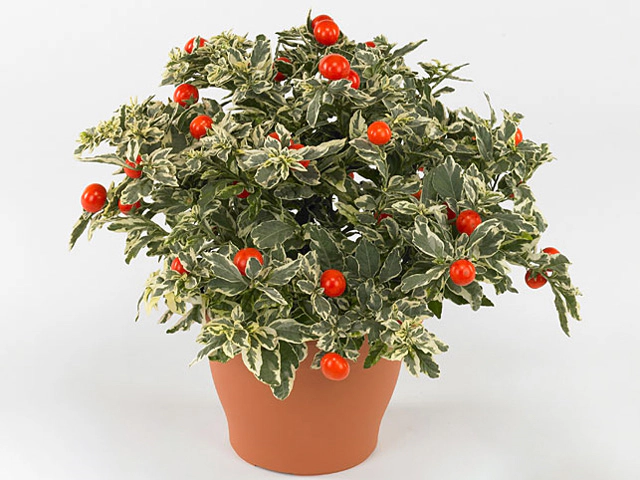Solanum pseudocapsicum Blushberry

| Fruit shape | Rounded-flattened |
| Leaf margin | Entire; Lobed |
| Fruit color | Orange-orange red-N030B |
| Leaf, general shape | Elongate |
| Plant height | 20 - 30 cm |
| Leaf surface | Bullate |
| Leaf size | 5 - 7,5 cm |
| Light conditions | Sunny |
| Leaf, main color | Green grey |
| Leaf colour, pattern | Bicolored |
| Leaf, secondary color(s) | Cream |
Solanum pseudocapsicum, commonly known as Blushberry or Nightshade, is a unique and fascinating plant that belongs to the nightshade family. This small perennial plant has distinct features that make it stand out in any garden or landscape.
The Blushberry has a rounded-flattened fruit shape, which adds to its charm. The fruits start out as a vibrant orange color and gradually turn into an orange-red shade with a hint of N030B. These colorful fruits create a striking contrast against the lush green foliage, making it a popular choice for ornamental purposes.
The leaves of the Blushberry are elongate and have an entire or lobed margin. They have a bullate surface, which means they are blistered or wrinkled, adding texture to the plant. The leaf size ranges from 5 to 7.5 cm, and they exhibit a bicolored pattern. The main color of the leaf is a green-grey shade, while the secondary color is a creamy hue.
Blushberry thrives in sunny conditions, making it an excellent addition to gardens with plenty of sunlight. The plant typically reaches a height of 20 to 30 cm, making it a compact and manageable choice for smaller spaces.
One of the unique characteristics of the Blushberry is its potential toxicity. Like other nightshade plants, it contains alkaloids that can be harmful if ingested. It's important to exercise caution and keep this plant away from children and pets.
In addition to its ornamental appeal, the Blushberry is also valued for its medicinal properties. The fruits of this plant have traditionally been used in herbal medicine for various purposes. They are rich in antioxidants and have been known to possess anti-inflammatory and detoxifying properties.
When cultivating the Blushberry, it's crucial to provide well-drained soil and regular watering. This plant does not tolerate waterlogged conditions and may develop root rot if exposed to excessive moisture. Proper care and maintenance will ensure the plant continues to thrive and produce its vibrant fruits.
In conclusion, Solanum pseudocapsicum, or Blushberry, is an eye-catching plant with its rounded-flattened fruits and distinctive foliage. With its compact size and beautiful orange-red color, it adds a touch of vibrancy to any garden. However, it's essential to handle this plant with care due to its potentially toxic nature. With the right conditions and proper care, Blushberry can be a delightful addition to your outdoor space, offering both aesthetic appeal and potential health benefits.
Market availability index by month:
| Jan. | Feb. | Mar. | Apr. | May | Jun. | Jul. | Aug. | Sep. | Oct. | Nov. | Dec. |
|---|---|---|---|---|---|---|---|---|---|---|---|
| 2 | 2 | 1 | - | - | 1 | 1 | 4 | 4 | 3 | 2 | 1 |